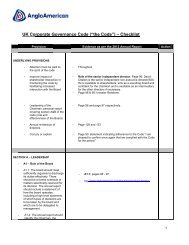Anglo American Annual Report 2012
Anglo American Annual Report 2012
Anglo American Annual Report 2012
- No tags were found...
You also want an ePaper? Increase the reach of your titles
YUMPU automatically turns print PDFs into web optimized ePapers that Google loves.
1. ACCOUNTING POLICIES continuedAmounts arising from interests in the acquiree prior to the acquisition datethat have previously been recognised in other comprehensive income arereclassified to the income statement, where such treatment would beappropriate if that interest were disposed of.Transaction costs incurred in connection with the business combination areexpensed. Provisional fair values are finalised within 12 months of theacquisition date.Goodwill in respect of subsidiaries and joint ventures is included withinintangible assets. Goodwill relating to associates is included within thecarrying value of the associate.Where the fair value of the identifiable net assets acquired exceeds the cost ofthe acquisition, the surplus, which represents the discount on the acquisition,is recognised directly in the income statement in the period of acquisition.For non-wholly owned subsidiaries, non-controlling interests are initiallyrecorded at the non-controlling interest’s proportion of the fair values ofnet assets recognised at acquisition.Property, plant and equipmentMining properties and leases include the cost of acquiring and developingmining properties and mineral rights.Mining properties are depreciated to their residual values using the unitof production method based on proven and probable ore reserves and,in certain limited circumstances, other mineral resources. Mineral resourcesare included in depreciation calculations where there is a high degree ofconfidence that they will be extracted in an economic manner. For diamondoperations, depreciation calculations are based on mineral reserves andresources included in the Life of Mine Plan. Depreciation is charged on newmining ventures from the date that the mining property is capable ofcommercial production. When there is little likelihood of a mineral right beingexploited, or the value of the exploitable mineral right has diminished belowcost, an impairment loss is recognised in the income statement.For open pit operations the removal of overburden or waste ore is requiredto obtain access to the orebody. To the extent that the actual waste materialremoved per tonne of ore mined (known as the stripping ratio) is higher thanthe average stripping ratio, costs associated with this process are deferredand charged to operating costs using the expected average stripping ratioover the life of the area being mined. This reflects the fact that waste removalis necessary to gain access to the orebody and therefore realise futureeconomic benefit. The average stripping ratio is calculated as the numberof tonnes of waste material expected to be removed during the Mine Life,per tonne of ore expected to be mined. The cost of stripping in any periodwill therefore be reflective of the average stripping ratio for the orebody asa whole applied to the actual stripping costs incurred. However, where the pitprofile is such that the actual stripping ratio is cumulatively below the average,no deferral takes place as this would result in the recognition of a liability forwhich there is no obligation. Instead, this position is monitored and when thecumulative calculation reflects a debit balance, deferral commences. Theaverage Mine Life stripping ratio is recalculated annually in light of additionalknowledge and changes in estimates. Changes in the Mine Life stripping ratioare accounted for prospectively as a change in estimate.Properties in the course of construction are measured at cost less anyrecognised impairment. Depreciation commences when the assets are readyfor their intended use. Buildings and plant and equipment are depreciated totheir residual values at varying rates on a straight line basis over theirestimated useful lives or the Mine Life, whichever is shorter. Estimated usefullives normally vary from up to 20 years for items of plant and equipment to amaximum of 50 years for buildings. Land is not depreciated.When parts of an item of property, plant and equipment have different usefullives, they are accounted for as separate items (major components).Depreciation methods, residual values and estimated useful lives arereviewed at least annually.Assets held under finance leases are depreciated over the shorter of the leaseterm and the estimated useful lives of the assets.Gains or losses on disposal of property, plant and equipment are determinedby comparing the proceeds from disposal with the carrying amount. The gainor loss is recognised in the income statement.Non-mining licences and other intangiblesNon-mining licences and other intangibles are measured at cost lessaccumulated amortisation and accumulated impairment losses. Intangibleassets acquired as part of an acquisition of a business are capitalisedseparately from goodwill if the asset is separable or arises from contractual orlegal rights and the fair value can be measured reliably on initial recognition.Intangible assets are amortised over their estimated useful lives, usuallybetween 3 and 20 years, except goodwill and those intangible assets thatare considered to have indefinite lives. For intangible assets with a finite life,the amortisation period is determined as the period over which the Groupexpects to obtain benefits from the asset, taking account of all relevant factsand circumstances including contractual lives and expectations about therenewal of contractual arrangements without significant incremental costs.An intangible asset is deemed to have an indefinite life when, based on ananalysis of all of the relevant factors, there is no foreseeable limit to the periodover which the asset is expected to generate cash flows for the Group.Amortisation methods, residual values and estimated useful lives arereviewed at least annually.Impairment of property, plant and equipment and intangibleassets excluding goodwillAt each reporting date, the Group reviews the carrying amounts of itsproperty, plant and equipment and intangible assets to determine whetherthere is any indication that those assets are impaired. If such an indicationexists, the recoverable amount of the asset is estimated in order to determinethe extent of any impairment. Where the asset does not generate cash flowsthat are independent from other assets, the Group estimates the recoverableamount of the cash generating unit (CGU) to which the asset belongs. Anintangible asset with an indefinite useful life is tested for impairment annuallyand whenever there is an indication that the asset may be impaired.Recoverable amount is the higher of fair value (less costs to sell) and value inuse. In assessing value in use, the estimated future cash flows are discountedto their present value using a pre-tax discount rate that reflects currentmarket assessments of the time value of money and the risks specific to theasset for which estimates of future cash flows have not been adjusted.If the recoverable amount of an asset or CGU is estimated to be less thanits carrying amount, the carrying amount of the asset or CGU is reducedto its recoverable amount. An impairment loss is recognised in the incomestatement as a special item.Where an impairment loss subsequently reverses, the carrying amountof the asset or CGU is increased to the revised estimate of its recoverableamount, but so that the increased carrying amount does not exceed thecarrying amount that would have been determined had no impairment beenrecognised for the asset or CGU. A reversal of an impairment loss isrecognised in the income statement as a special item.Impairment of goodwillGoodwill arising on business combinations is allocated to the group of CGUsthat is expected to benefit from synergies of the combination, and representsthe lowest level at which goodwill is monitored by the Group’s board ofdirectors for internal management purposes. The recoverable amount of theCGU or group of CGUs to which goodwill has been allocated, is tested forimpairment annually, or when events or changes in circumstances indicatethat it may be impaired.Any impairment loss is recognised immediately in the income statement asa special item. Impairment of goodwill is not subsequently reversed.Exploration, evaluation and development expenditureExploration and evaluation expenditure is expensed in the year in which it isincurred. When a decision is taken that a mining property is economicallyfeasible, all subsequent evaluation expenditure is capitalised within property,plant and equipment including, where applicable, directly attributablepre-production development expenditure. Capitalisation of such expenditureceases when the mining property is capable of commercial production.Exploration properties acquired are recognised in the balance sheet at costless any accumulated impairment losses. Such properties and capitalisedevaluation and pre-production development expenditure prior to commercialproduction are assessed for impairment in accordance with the Group’saccounting policy stated above.Financial statements<strong>Anglo</strong> <strong>American</strong> plc <strong>Annual</strong> <strong>Report</strong> <strong>2012</strong> 143



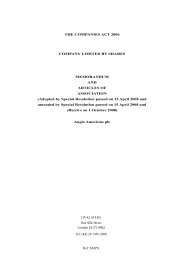
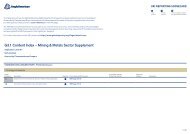
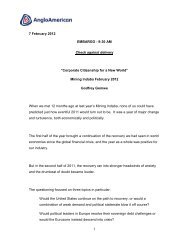
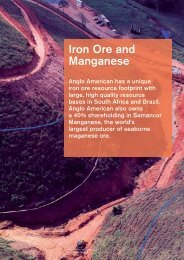
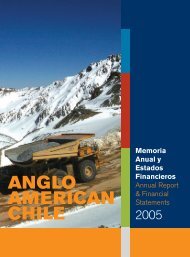
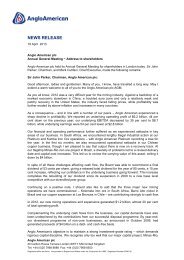
![English PDF [ 189KB ] - Anglo American](https://img.yumpu.com/50470814/1/184x260/english-pdf-189kb-anglo-american.jpg?quality=85)
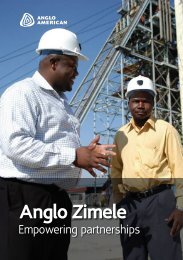

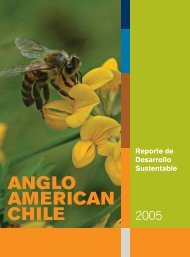
![pdf [ 595KB ] - Anglo American](https://img.yumpu.com/49420483/1/184x260/pdf-595kb-anglo-american.jpg?quality=85)
![pdf [ 1.1MB ] - Anglo American](https://img.yumpu.com/49057963/1/190x240/pdf-11mb-anglo-american.jpg?quality=85)
